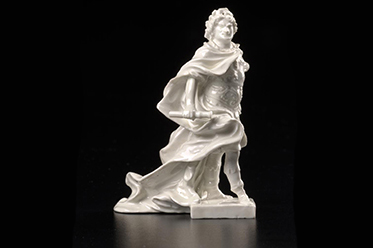 The National Gallery of Victoria (NGV) will present its renowned collection of eighteenth-century porcelain sculpture in an upcoming exhibition from 27 February, revealing eighteenth-century baroque life and culture – from commoners and aristocrats to famous actors and musicians.
The National Gallery of Victoria (NGV) will present its renowned collection of eighteenth-century porcelain sculpture in an upcoming exhibition from 27 February, revealing eighteenth-century baroque life and culture – from commoners and aristocrats to famous actors and musicians.
Eighteenth-Century Porcelain Sculpture will showcase over eighty exquisite examples from famed European factories including the German Meissen, French Sèvres and English Derby factories, of intricately modelled porcelain figures, large-scale sculptural works and celebrity portraits.
“The NGV holds the largest collection of porcelain sculpture in Australia and this exhibition offers an opportunity to view a number of our rarest and most important works, including the Chelsea Porcelain Factory’s large-scale Pietà sculpture of which the NGV owns two of the only three examples in the world,” said Tony Ellwood, Director NGV.
Whilst today porcelain sculptures are often considered ‘decorative’ items, in the eighteenth century many of the finest artists of the time were drawn to the novel medium. The exhibition will include the work of key modellers such as Johann Joachim Kändler – the era’s most important ceramic sculptor and a major innovator, Franz Anton Bustelli, Johann Peter Melchior and Giuseppe Gricci, court sculptor to King Charles VII of Naples.
The exhibition also includes rare porcelain sculptures of popular eighteenth-century London stage actors including Kitty Clive, Henry Woodward, David Garrick and James Quinn. Collected by wealthy members of the elite, these figures give insight into the growing culture of celebrity in eighteenth-century England and demonstrate how porcelain became an important medium for the dissemination of popular imagery.
Another highlight is the exceptionally rare Goffredo at the tomb of Dudone, modelled by Giuseppe Gricci for the Neopolitan Capodimote factory, which portrays an episode from Tasso’s great Renaissance epic poem Jerusalem liberated.
Due to the fragile nature of porcelain sculpture, NGV conservators have undertaken five months of restoration work to return many of these pieces to display. One sculpture, by the Italian Doccia factory of a shepherd and his companion, will be displayed for the first time in more than twenty years.
Individual fingers no more than 2mm across were remade from porcelain and skilfully attached to the shepherd’s hand, an incredibly delicate procedure that required three attempts. Conservators have also removed discolouration from other pieces enabling them to be displayed once more in all of their original beauty.
The exhibition is accompanied by an online essay by Matthew Martin and public program offerings including floor talks which will provide unique insights into the period.
Eighteenth-Century Porcelain Sculpture
NGV International, 180 St. Kilda Road, Melbourne
Exhibition: 27 February to December 2016
Free admission
For more information, visit: www.ngv.vic.gov.au for details.
Image: MEISSEN PORCELAIN FACTORY, Meissen (manufacturer); Johann Joachim KRETZSCHMAR (modeller), Augustus the Strong Elector of Saxony and King of Poland (1714-1725) porcelain (hard-paste) 10.9 x 7.3 x 6.3 cm National Gallery of Victoria, Melbourne. Everard Studley Miller Bequest, 1975
